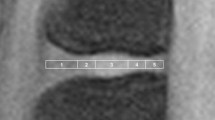Abstract
Objective
Magnetic resonance T2 mapping allows for the quantification of water and proteoglycan content within tissues and can be used to detect early cartilage abnormalities as well as to track the response to therapy. The goal of the present study was to use T2 mapping to quantify intervertebral disk water content according to the Pfirrmann classification.
Materials and methods
This study involved 60 subjects who underwent lumbar magnetic resonance imaging (a total of 300 lumbar disks). The degree of disk degeneration was assessed in the midsagittal section on T2-weighted images according to the Pfirrmann classification (grades I to V). Receiver operating characteristic (ROC) analysis was performed among grades to determine the cut-off values.
Results
In the nucleus pulposus, T2 values tended to decrease with increasing grade, and there was a significant difference in T2 values between each grade from grades I to IV. However, there was no significant difference in T2 values in the anterior or posterior annulus fibrosus. T2 values according to disk degeneration level classification were as follows: grade I (>116.8 ms), grade II (92.7–116.7 ms), grade III (72.1–92.6 ms), grade IV (<72.0 ms).
Conclusion
T2 values decreased with increasing Pfirrmann classification grade in the nucleus pulposus, likely reflecting a decrease in proteoglycan and water content. Thus, T2 value-based measurements of intervertebral disk water content may be useful for future clinical research on degenerative disk diseases.



Similar content being viewed by others
References
Andersson GB. Epidemiology of low back pain. Acta Orthop Scand Suppl. 1998;281:28–31.
Benneker LM, Heini PF, Anderson SE, Alini M, Ito K. Correlation of radiographic and MRI parameters to morphological and biochemical assessment of intervertebral disc degeneration. Eur Spine J. 2005;14(1):27–35.
Praemer A, Furner S, Rice DP, American Academy of Orthopaedic Surgeons. Musculoskeletal conditions in the United States. 1st ed. Park Ridge, IL: American Academy of Orthopaedic Surgeons, 1992
Paajanen H, Erkintalo M, Parkkola R, Salminen J, Kormano M. Age-dependent correlation of low-back pain and lumbar disc regeneration. Arch Orthop Trauma Surg. 1997;116(1–2):106–7.
Salminen JJ, Erkintalo MO, Pentti J, Oksanen A, Kormano MJ. Recurrent low back pain and early disc degeneration in the young. Spine (Phila Pa 1976). 1999;24(13):1316–21.
Weinstein JN, Gordon SL, Buckwalter JA, American Academy of Orthopaedic Surgeons. Low back pain: a scientific and clinical overview. 1st ed. Rosemont, IL: American Academy of Orthopaedic Surgeons, 1996
Hardy PA. Intervertebral disks on MR images: variation in signal intensity with the disk-to-magnetic field orientation. Radiology. 1996;200(1):143–7.
Ludescher B, Effelsberg J, Martirosian P, Steidle G, Markert B, Claussen C, et al. T2- and diffusion-maps reveal diurnal changes of intervertebral disc composition: an in vivo MRI study at 1.5 Tesla. J Magn Reson Imaging. 2008;28(1):252–7.
Nightingale T, MacKay A, Pearce RH, Whittall KP, Flak B. A model of unloaded human intervertebral disk based on NMR relaxation. Magn Reson Med. 2000;43(1):34–44.
Urban JP, McMullin JF. Swelling pressure of the lumbar intervertebral discs: influence of age, spinal level, composition, and degeneration. Spine (Phila Pa 1976). 1988;13(2):179–87.
Zou J, Yang H, Miyazaki M, Morishita Y, Wei F, McGovern S, et al. Dynamic bulging of intervertebral discs in the degenerative lumbar spine. Spine (Phila Pa 1976). 2009;34(23):2545–50.
Pfirrmann CW, Metzdorf A, Zanetti M, Hodler J, Boos N. Magnetic resonance classification of lumbar intervertebral disc degeneration. Spine (Phila Pa 1976). 2001;26(17):1873–8.
Friedrich KM, Shepard T, de Oliveira VS, Wang L, Babb JS, Schweitzer M, et al. T2 measurements of cartilage in osteoarthritis patients with meniscal tears. AJR Am J Roentgenol. 2009;193(5):W411–5.
Mosher TJ, Dardzinski BJ. Cartilage MRI T2 relaxation time mapping: overview and applications. Semin Musculoskelet Radiol. 2004;8(4):355–68.
Weidenbaum M, Foster RJ, Best BA, Saed-Nejad F, Nickoloff E, Newhouse J, et al. Correlating magnetic resonance imaging with the biochemical content of the normal human intervertebral disc. J Orthop Res. 1992;10(4):552–61.
Blumenkrantz G, Zuo J, Li X, Kornak J, Link TM, Majumdar S. In vivo 3.0-tesla magnetic resonance T1rho and T2 relaxation mapping in subjects with intervertebral disc degeneration and clinical symptoms. Magn Reson Med. 2010;63(5):1193–1200.
Karakida O, Ueda H, Ueda M, Miyasaka T. Diurnal T2 value changes in the lumbar intervertebral discs. Clin Radiol. 2003;58(5):389–92.
Perry J, Haughton V, Anderson PA, Wu Y, Fine J, Mistretta C. The value of T2 relaxation times to characterize lumbar intervertebral disks: preliminary results. AJNR Am J Neuroradiol. 2006;27(2):337–42.
Boos N, Wallin A, Gbedegbegnon T, Aebi M, Boesch C. Quantitative MR imaging of lumbar intervertebral disks and vertebral bodies: influence of diurnal water content variations. Radiology. 1993;188(2):351–4.
Krueger EC, Perry JO, Wu Y, Haughton VM. Changes in T2 relaxation times associated with maturation of the human intervertebral disk. AJNR Am J Neuroradiol. 2007;28(7):1237–41.
Chiu EJ, Newitt DC, Segal MR, Hu SS, Lotz JC, Majumdar S. Magnetic resonance imaging measurement of relaxation and water diffusion in the human lumbar intervertebral disc under compression in vitro. Spine (Phila Pa 1976). 2001;26(19):E437–44.
Gundry CR, Fritts HM. Magnetic resonance imaging of the musculoskeletal system. VIII. The spine, section 2. Clin Orthop Relat Res. 1997;343:260–71.
Modic MT, Pavlicek W, Weinstein MA, Boumphrey F, Ngo F, Hardy R, et al. Magnetic resonance imaging of intervertebral disk disease. Clinical and pulse sequence considerations. Radiology. 1984;152(1):103–11.
Watanabe A, Benneker LM, Boesch C, Watanabe T, Obata T, Anderson SE. Classification of intervertebral disk degeneration with axial T2 mapping. AJR Am J Roentgenol. 2007;189(4):936–42.
Marinelli NL, Haughton VM, Munoz A, Anderson PA. T2 relaxation times of intervertebral disc tissue correlated with water content and proteoglycan content. Spine (Phila Pa 1976). 2009;34(5):520–4.
Marinelli NL, Haughton VM, Anderson PA. T2 Relaxation times correlated with stage of lumbar intervertebral disk degeneration and patient age. AJNR Am J Neuroradiol. 2010;31(7):1278–82.
Acknowledgement
Conflict of interest
The authors declare that there is no conflict of interest.
Author information
Authors and Affiliations
Corresponding author
Rights and permissions
About this article
Cite this article
Takashima, H., Takebayashi, T., Yoshimoto, M. et al. Correlation between T2 relaxation time and intervertebral disk degeneration. Skeletal Radiol 41, 163–167 (2012). https://doi.org/10.1007/s00256-011-1144-0
Received:
Revised:
Accepted:
Published:
Issue Date:
DOI: https://doi.org/10.1007/s00256-011-1144-0




